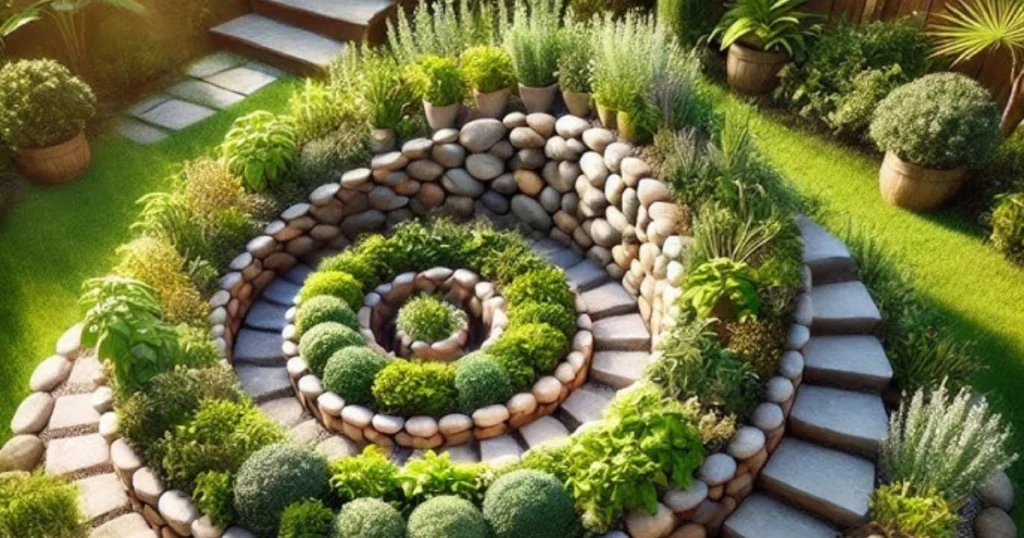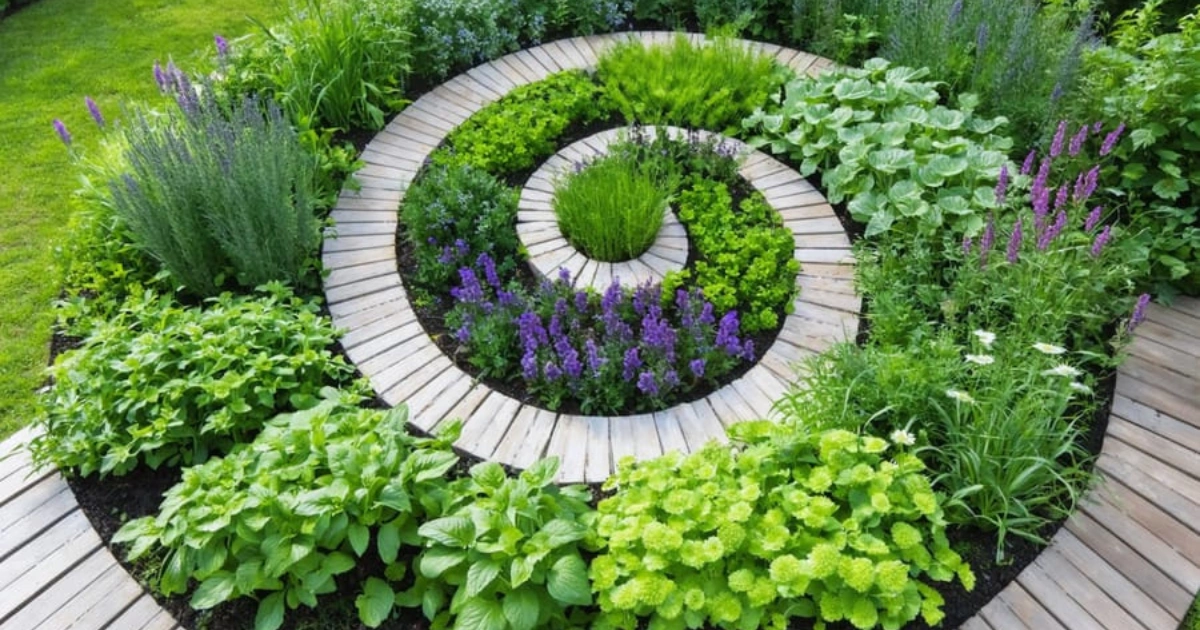In permaculture circles, the herb spiral is a celebrated design that blends beauty, function, and efficiency. It’s more than just an eye-catching garden feature—it’s a clever way to grow a wide variety of herbs in a compact footprint, while naturally creating the right growing conditions for each plant.
By using a spiral-shaped mound of soil, you take advantage of natural slopes and orientations to offer sun-loving, drought-tolerant plants a home at the top, while moisture-loving herbs thrive at the base. This tiered approach not only saves space but also supports biodiversity and improves yields throughout the year.

How the Herb Spiral Works
The concept is simple: build a spiral-shaped bed that gradually descends from a central high point to ground level. This change in height, combined with strategic positioning, creates multiple microclimates in a single structure.
- Top of the spiral: The sunniest and driest zone, perfect for Mediterranean herbs like rosemary, thyme, and lavender.
- Base of the spiral: Cooler and moisture-rich, ideal for plants such as mint, parsley, and lemon balm.
- Southwest-facing slope: Receives the most direct sun and warmth, favoring heat-loving herbs like oregano and basil.
- Northeast side: Stays shaded and humid for longer, making it suitable for delicate herbs like chervil, chamomile, or tarragon.
This arrangement mimics natural ecosystems, where plants grow in niches best suited to their needs.
Benefits of a Herb Spiral
A well-built herb spiral does far more than just look good in your garden. Here are the main advantages:
- Maximizes limited space – Fits up to 20 different herbs in a small area.
- Reduces watering needs – Water naturally flows down, keeping moisture-loving plants hydrated while drier herbs avoid soggy roots.
- Encourages biodiversity – Attracts pollinators, beneficial insects, and improves soil health.
- Extends the harvest season – Different microclimates help herbs grow for longer periods.
- Low maintenance – Once established, requires minimal weeding and upkeep.
Choosing Herbs for Each Zone
A herb spiral can host a mix of culinary, medicinal, and decorative plants. Here’s a suggested planting guide:
Top – Dry and Sunny
- Rosemary
- Thyme
- Lavender
- Sage
Middle – Warm with Moderate Moisture
- Oregano
- Basil
- Dill
- Tarragon
- Marigold (also helps deter pests)
Base – Cool and Moist
- Mint (contain roots with a pot or barrier to prevent spreading)
- Parsley
- Lemon Balm
- Chervil
- Chamomile
Step-by-Step: Building a Herb Spiral
- Choose Your Location
Select a sunny spot—most herbs need at least 6 hours of direct sunlight daily. - Mark the Spiral Shape
Use a rope or hose to lay out a spiral pattern on the ground, about 1.5–2 meters (5–6 feet) in diameter. - Build the Base
Start with stones, bricks, or reclaimed materials to form the edges of the spiral. - Add Soil Layers
Fill with well-draining soil, mixing in compost for nutrients. The top should be higher and gradually slope downward. - Plant According to Zones
Position herbs based on their sun and water needs, starting from the top down. - Mulch and Water
Mulch helps retain moisture and reduce weeds. Water thoroughly after planting.
Tips for Success
- Rotate Crops Seasonally – Swap plants between zones if light or moisture changes during the year.
- Integrate Companion Plants – Pair herbs that benefit each other’s growth, like basil and oregano.
- Add Decorative Elements – Edible flowers like nasturtiums or calendula add color and attract pollinators.
- Prevent Overcrowding – Give each plant enough space to mature.
- Control Spreading Herbs – Contain invasive growers like mint to prevent them from overtaking the spiral.
Eco-Friendly Advantages
A herb spiral is a sustainable design choice for several reasons:
- Reduces resource use – Less water and fertilizer are needed compared to traditional flat beds.
- Promotes pollinator health – Flowers attract bees and butterflies, improving pollination for nearby crops.
- Uses recycled materials – You can build it with reclaimed stone, brick, or even broken tiles.
- Improves soil health – Diverse planting encourages beneficial soil organisms.
Year-Round Harvest Potential
Because of the range of microclimates, a herb spiral supports herbs in different seasons. Hardy perennials like rosemary and thyme can survive mild winters, while annuals like basil and dill thrive in the warmest months. This means you can enjoy fresh flavors for cooking and natural remedies almost all year.
Frequently Asked Questions
1. How much space do I need for a herb spiral?
Most designs fit into an area about 6 feet (1.8 meters) wide, but you can scale it up or down depending on available space.
2. Can I build one on a balcony or patio?
Yes. Mini herb spirals can be created in large containers or raised planters.
3. Do I need special soil for a herb spiral?
A well-draining mix with compost works best. Sandy soil is ideal for the top, while richer, loamier soil benefits plants at the bottom.
4. How often should I water?
Watering frequency depends on weather and plant needs. The top zone will dry out faster, so check regularly.
5. What’s the best time to plant?
Spring is ideal, but you can plant at any time if temperatures are mild and frost is not a concern.
Main keyword: herb spiral garden
LSI/NLP keywords: permaculture herb spiral, microclimate gardening, herb spiral design, sustainable gardening, compact herb garden, medicinal herbs, culinary herbs
Internal link suggestions from secretsofthegreengarden.com:
- Best Herbs to Grow Indoors and Outdoors
- Companion Planting for a Healthier Garden
- How to Create a Drought-Tolerant Garden
External link suggestions: - Permaculture Research Institute – Herb Spiral Design
- Royal Horticultural Society – Growing Herbs
- GrowVeg – Companion Planting Guide

